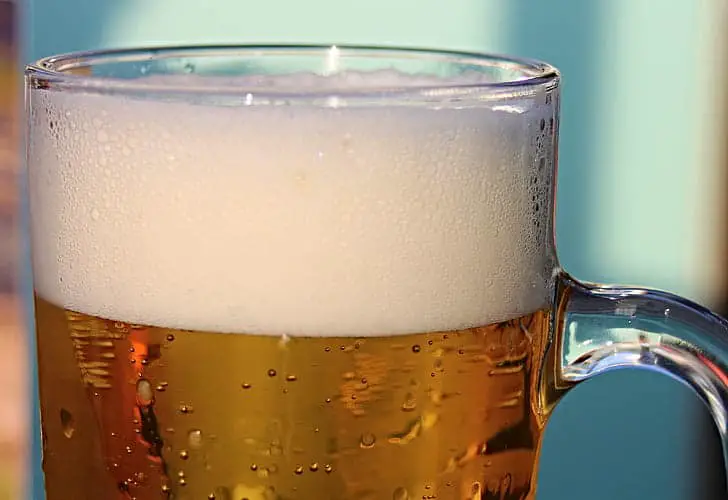Yeast is the secret behind high-quality beer production. It ferments malt sugars, producing carbon dioxide and alcohol.
Yeast produces a whole range of flavoring components during fermentation. It includes esters, phenols, and a wide selection of other chemicals. Yeast causes the distinct difference between the German Hefeweizen and American Blond Ale.
Controlling fermentation is the most important aspect of making good quality beers. This entails choosing the correct strain of yeast. We need to treat yeast to go through a healthy and thorough fermentation.
WHAT IS FERMENTATION: The Fermentation Phases
Fermentation occurs in three stages. First, you pitch the yeast to the wort. Yeast absorbs dissolved oxygen. Most common yeasts are distillers and bakers. It uses various minerals that exist within the wort to build up cell walls. Then, the yeast starts to divide. And it increases the number of cells according to the conditions under which they are in. This phase creates the most flavor compounds. It will last anywhere from 6 hours to two days. We call this delay timeframe as lag time.
The second phase is an active fermentation. You want to add more yeast if you want faster digestion of sugar. This produces alcohol and carbon dioxide. This stage is critical because temperature plays a big role in fermentation. We should keep the temperature within the yeast range. Otherwise, the beer can grow off-flavors. If it is too hot or too cool, it will stall out. A krausen will form and the airlock causes frequent bubbles. Krausen is the thick frothy layer that builds up during this stage. It consists of proteins as by-products. And yeast cells are being pushed up by the produced carbon dioxide. This stage lasts 5-10 days.
The third and final phase is conditioning. Yeasts slow down and digest the final sugars. The krausen will begin to fall and sink back into the beer, and a layer of trub will develop on the bottom. Then yeast will clean up harsh by-products produced during the first two phases. This stage is essential as it improves the taste of the brew. This stage lasts 4-7 days depending on the alcohol percentage. It is best practice to keep the beer in the primary fermenter for at least 2-3 weeks before bottling or kegging.
Can You Speed Up Beer Fermentation?
It is possible to produce beers in as little as four to five days. Yet, there are limits on the processes before you can mass produce. For it to be faster, you have to end different approaches that are at odds with a quick turnaround process. If you want to quaff your beer, you need to forget about true lagers, high gravity beers, and sour beers. All these take longer periods of time to ferment. This leaves low to moderate gravity ales as your best choice. Typical ale fermentation finishes in two to five days. Ale strains operate at a warmer temperature than lagers. They are more conducive to reaching the final specific gravity faster than others.
Pitch Enough Yeast
There are several techniques to reduce the time until fermentation finishes. The first, and most important, of these, is to pitch an adequate amount of yeast. For a 5 gallon (19-L) load of low to moderate gravity ale, a 1–2 quarter (~ 1–2 L) yeast starters required. Give your starter about 1.030-1.040 with a reasonable gravity. Aerate it well and add a pinch of yeast nutrients. Pitching a bigger starter may help speed the fermentation a bit, but there’s no need to overdo it.
Pitch your new batch onto the yeast from a prior batch to get a rapid onset of fermentation. One cup of yeast slurry will yield the most number of cells for a 5 gallon (19-L) batch.
Another choice is to pitch two packs or tubes of liquid yeast. This will give you about 200 billion cells, enough for 5 gallons (19 L) of quick turnaround ale. An appropriate strain of yeast should be available. Be sure to rehydrate the yeast before pitching it.
When pitched to a low to moderate gravity wort… the majority of ale strains should ferment faster. Yet, if you want to cut your turnaround time, look for a strain that ferments hard. It has to be at high flocculation. Even, since contact time with the beer will be limited… strong strain-reducing diacetyl is a bonus.
Fermentation Temperature
Every yeast strain has a temperature range in which it produces the best beer. That is around 68–72 ° F (20–22 ° F) for most English ale strains. For a quick turnaround beer, you will want to ferment in the middle to the high end of your yeast’s range. Colder temperatures cause fermentation to go slow. Fermenting ale higher than the recommended temperature will make the fermentation go faster. Moreover, the resulting beer is likely to be too fruity due to the esters’ overproduction. Owing to the presence of higher alcohols (“fusel oils”), this could also be undrinkable.
Aerate Well
Aerating the wort should be before fermentation to speed up the process. If you use oxygen, give the wort a one-minute shot, swirling your fermenter as you go. If you use air — for example, pumped with an aquarium pump through a HEPA filter, let it go for 5–10 minutes while swirling the wort from time to time. You may have to stop a few times to let the foam subside.
For low-to-moderate strength ale, one shot of aeration should be enough. Longer aeration times will not make your fermentation start to proceed faster. Many aerations before fermentation starts may cause more problems than benefits.
Aerate while pitching enough yeast. Fermenting above the yeast’s temperature range should yield fermentation. It speeds up the process while produces good quality beer. Trying to rev the excess yeast… for instance by massively overpitching or conducting the fermentation too hot… slows fermentation time, but changes the beer quality.
Here’s a recipe you can try as an example:
Speedy Recipes
- It’s Just A Starter (6-Day Mild Ale)
- (5 gallon/19 L, all-grain)
- OG = 1.036 FG = 1.007
- IBU = 24 SRM = 31 ABV = 3.6%
The name reflects the use of the most recent batch of mild. You have to grow enough yeast to make a batch of OG 1.116 barley wine for filling a bourbon barrel. We should add to the keg the mild made the previous day while the barley wine mash is underway. The chilled barley wine wort was then moved from the mild to the yeast cake, adding a bit of oxygen. There should have an activity in the airlock within about an hour.
Ingredients
- 4.66 lbs. (2.11 kg) 2-row pale malt
- 0.97 lbs. (0.44 kg) crystal malt (55 °L)
- 0.40 lbs. (0.18 kg) chocolate malt
- 1.17 lbs. (0.53 kg) flaked corn
- 0.25 lbs. (0.11 kg) crystal malt (150 °L)
- 6.2 AAU Fuggles hops (60 mins)
- (1.55 oz./44 g of 4% alpha acid)
- Wyeast 1968 (London ESB) or
- White Labs WLP002 (English Ale) yeast
- 0.66 cups corn sugar (for priming)
Step by Step
Mash at 152 °F (67 °C) for 45 minutes with 1.33 quarts of water per pound of grain — 2.48 gallons (9.4 L) total. Sparge with 168° F (75 °C) water until you collect 6.5 gallons (25 L) of wort. Boil the wort for 60 minutes. Chill to the temperature of the main fermentation and pitch the yeast. You can rack the beer off your carboy and into a keg after 6 days. Force carbonate to about 2 volumes of CO2 and enjoy.
Does It Affect The Taste Of Your Homebrew?
Most likely, yes.
Fermentation improves the taste and aroma of a good quality beer… as well as high ethanol and beer productivity. Breweries indeed use high gravity worts and ferment at higher temperatures. It is to save energy, space, and time. The product dilutes using deaerated water to get the desired alcohol content after fermentation.
Increased temperature and pitching rate enhances the rate of fermentation… by promoting yeast growth. Yet, these approaches have several disadvantages. This includes altered beer flavor at the end of primary fermentation and detrimental effects on yeast viability… leading to poor fermentation performance.
The increased effects of ethanol at higher temperatures have attributed to the increasing accumulation of intracellular ethanol. Thus, decreased fermentation times can result in poor yeast viability. A higher fermentation temperature increases the number of budding cells… the intensity of the process and metabolic changes.
To Help You Prepare For A Speed Up Fermentation, Here Are 6 Tips To Guide You:
1. Organize the Day Before
Make sure everything you needed on brew day was where it needed to be. Pot cleaned? Check. Fermenter cleaned and filled with sanitizer? Check. A bucket filled with sanitizer? Check.
2. Use Preheated Water
For most homebrewers, the biggest time-waster is water heating. If you are brewing extract or all-grain, it doesn’t matter if it takes time to get the water up to temperature. The night before, you can turn up your hot water heater to the hottest setting.
Warning: Be very careful about handling hot things. It might cause an unnecessary accident if you fail to take precautions.
3. Multitask
During the “dead time” of mashing/boil, you can start to get anything ready for the post-boil. Take a partially filled fermenter bucket or carboy. Give it a shake and drain the excess sanitizer. Then seal the bucket and put an airlock on it so that nothing can enter.
.During the mash, start getting your boil additions lined up. This means weighing and sorting your hops, measuring Irish moss and yeast nutrients, and ready to go any other kettle additions calculations. This will help ensure that things go smoother.
4. Chill Faster
Unless you have an immersion chiller… Then you’re set up for that speedy process
5. Siphon Quicker by Not Siphoning at All
You can take some time off from your brew day by using a mesh strainer. Siphoning may take about 10-15 minutes. If you are brewing an ingredient, pour the brew through a strainer into your pot. You can attach a ball valve to your kettle and drain it into your bucket. The ball valve opening is bigger than the siphon tubing, allowing a quicker move.
Using all these tips will cut your daily brew by hours.

The Brewing Art is created to help dedicated homebrewers. My aim is to help people enjoy life and be committed to brewing for a better drinking experience. I also help starting entrepreneurs in the beverage industry pursue their passion by providing advice and information about quality brews.

